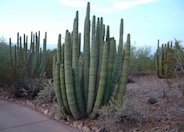
Common name:Summer Coreopsis
Botanical name:Coreopsis grandiflora
The Coreopsis, a plant which grows up to 30", produces striking double bright yellow flowers. It is excellent as cut flowers or as a backdrop. The bloom period occurs from spring to fall.

Common name:Trailing Gazania
Botanical name:Gazania rigens
This trailing groundcover grows at a moderate rate to 8" x 18". Leaves are silver to green. Billiant daisylike flowers come in many colors orange, bronze and yellow. Long bloom season from late winter to spring. Grows well in most soil conditions, and needs only occassional water once established. May die out if overwatered. Native to South Africa.

Common name:Red Yucca
Botanical name:Hesperaloe parviflora
Upright rosettes grow quickly to 3' x 5' wide. Spectacular accent for desert landscape. Leaves are dark green and strap-like. Coral red flower spikes emerge in spring & remain on plant till end of summer. Tolerates tough conditions including reflected heat and frost. Attracts humingbirds. Native to western Texas and northeastern Mexico.

Common name:Organ Pipe
Botanical name:Stenocereus thurberi
Evergreen columnar cactus grows slowly to 10' x 10'. Olive-green stems covered in black spines. Pale pink night blooming flowers appaer spring to summer. Accepts reflected heat. Striking focal point in the landscape given time. Native to the Sonoran Desert.

Common name:Santa Rita Prickly Pear
Botanical name:Opuntia violacea 'Santa Rita'
Shrublike cactus grows at a moderate rate to 4' x 5'. Pads are green-purple turning more purple with cold or dry weather. Small tan spines line the pads. Striking yellow flowers appear on the tips of pads in the spring. Accepts reflected heat. Native to the Sonoran and Chihuahuan deserts.
| Designer: Sallie Homan | Ridge Road Garden 3 |
Photographer: GardenSoft |
Soils and Compost:
Incorporate compost 6" into your soil to retain water, reduce compaction, feed earthworms, and provide valuable nutrients to your plants.
Water Saving Tip:
Remember to check your irrigation system at least once a month, especially your valves, sprinkler heads, and drip emitters.
Integrated Pest Management:
Drip and other smart irrigation delivers water directly to roots, allowing no excess water for weeds.
